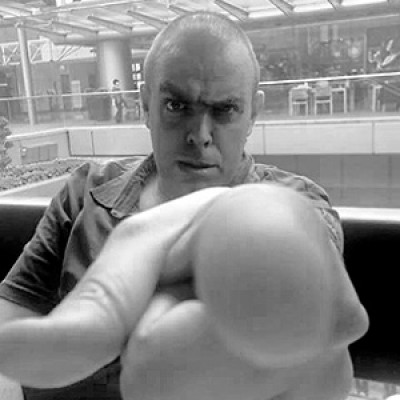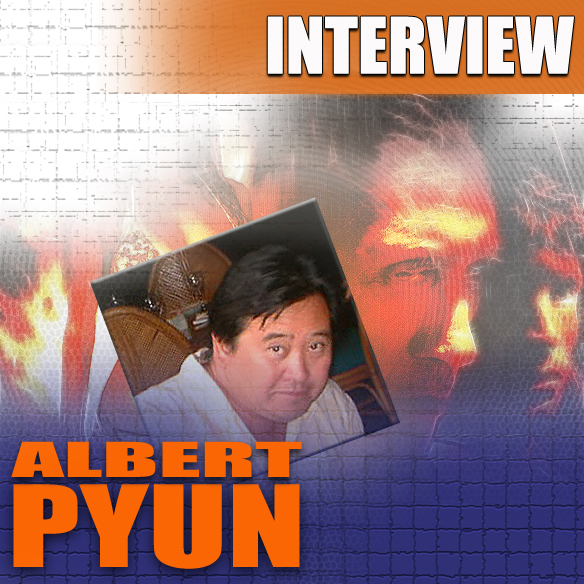 Impact has long championed the career of Albert Pyun... his filmography is a cult waiting to be cultivated. He’s helmed everything from classic sword and sorcery in The Sword & the Sorcerer; helped introduce the world to Jean-Claude Van Damme (with the cult classic Cyborg) and Olivier Gruner (with Nemesis); he was the man behind the budget-starved super heroics in the original Captain America film; worked with eclectic - and at times eccentric casts - in everything from Knights, Heatseeker, Ravenhawk, Brain Smasher to Hong Kong 97 and many more. He’s had Radioactive Dreams, and driven the Road to Hell and back.
Impact has long championed the career of Albert Pyun... his filmography is a cult waiting to be cultivated. He’s helmed everything from classic sword and sorcery in The Sword & the Sorcerer; helped introduce the world to Jean-Claude Van Damme (with the cult classic Cyborg) and Olivier Gruner (with Nemesis); he was the man behind the budget-starved super heroics in the original Captain America film; worked with eclectic - and at times eccentric casts - in everything from Knights, Heatseeker, Ravenhawk, Brain Smasher to Hong Kong 97 and many more. He’s had Radioactive Dreams, and driven the Road to Hell and back.
But one of his films in particular, has received so much controversial press over the years with allegedly false allegations made and quite a bit of mud being flung in Albert’s direction. That movie was Max Havoc: Curse of the Dragon... Albert talks to Mike Leeder about the project and for the first time gets to tell his side of the story...
The plot: Ex-Kickboxing champion-turned-sports-photographer Max Havoc (Mickey Hardt) finds himself in Guam - and up to his neck in trouble - when he makes the acquaintance of vacationing sisters Jane and Christy who have acquired a rare jade dragon. This dragon is the property of the Yakuza and they’ll stop at nothing to get it back.
Impact: Albert, what was the genesis of 'Max Havoc'? How did you first get involved with the project?
Albert Pyun: I was initially contacted in 2001 by John Laing and Rigel Entertainment. They had spent several years trying to get their project Max Havoc made in New Zealand and Australia. Since I was living in Hawaii at the time, he approached me with the idea of setting the film up to shoot in Hawaii with me as director. I had a Production Co-ordinator named Chris Bates hired and flown in from LA to be both UPM and lone producer for the film, and we began scouting locations for the film.
Then came the tragedy of Sept 11th 2001, and that put a stop to all plans to shoot in Hawaii, because Laing’s bank was in one of the twin towers and flights to Hawaii were cut back. We decided it might be a lot easier to shoot on the mainland and selected Miami - with Chris Bates being hired once more to scout the city and state with me. We did so extensively and decided that we could make Miami work for the tropical setting.
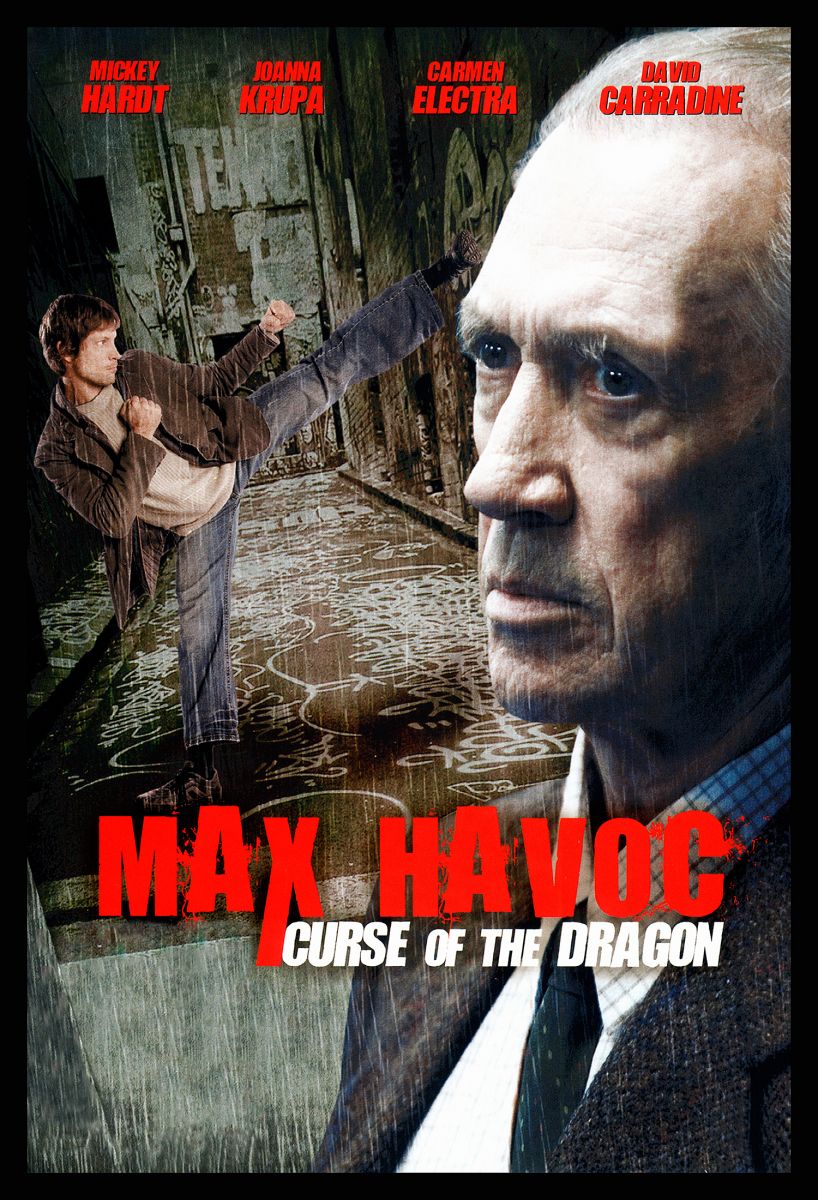 Before leaving for Miami, I met with another Hawaiian action movie veteran, Mark Dacascos about playing the lead. We had a good meeting and he was interested in coming aboard when our already battered production took another big hit... anthrax! The South Florida region was out, and Dacascos did not want to go to the area with Anthrax about. The project got shelved, and it ended the working relationship between myself and Chris Bates... as I don’t think he fully understood at the time what happened with the project.
Before leaving for Miami, I met with another Hawaiian action movie veteran, Mark Dacascos about playing the lead. We had a good meeting and he was interested in coming aboard when our already battered production took another big hit... anthrax! The South Florida region was out, and Dacascos did not want to go to the area with Anthrax about. The project got shelved, and it ended the working relationship between myself and Chris Bates... as I don’t think he fully understood at the time what happened with the project.
Now Laing had several pre-sale contracts for the film, that were rapidly approaching their due date and he needed to deliver the film or risk having the contracts cancelled. In late 2003, he got in touch with me about resurrecting the project, although at this point the funds for the film had shrunk. I had been trying to put together a film in Indonesia and thought that Bali would fit the needs of the producers and the story. So we started pre-production on a shoot there, using a great crew from Jakarta but then the Bali Night Club Bombing happened and that made all of Indonesia unbondable.
I scoured every possibility and happen to read about Guam in an ad. They proclaimed a great business environment and infrastructure. I did a little more research and read they had just been hit by a typhoon but businesses there with government support were reaching out to Japan. I thought, why not a US film instead of Japanese and Chinese production? So I got in touch with the Guam Economic Development Authority ( GEDA) who were behind the ads. I received quick replies from the agency's officer’s spear headed by David Silva.
I emailed a detailed package including the project's production requirements and background on Laing, Rigel and myself. David then convinced me that Guam could handle our production. Silva set up a meeting in Dec 2003. Laing flew from LA to Guam and he met with Silva, other GEDA officers, government officials, local business leaders and tourism leaders at the Marriott Hotel. They collectively promised Laing that Guam had the infrastructure to handle the production for his budget. Silva took Laing on scouting trips including the Governor's mansion which was under repair from the typhoon and the various night clubs on Guam. Laing returned to LA excited by what he saw and heard and the support he was pledged.
Thus the decision was made to shoot two films on Guam and John and Rigel was excited about an ongoing presence on Guam. That was how I came to be involved with the project and the shoot on Guam.
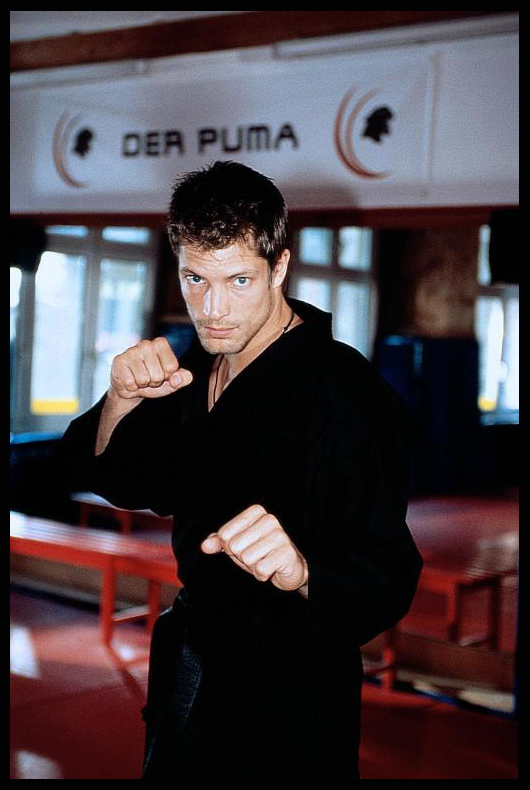 Impact: I had heard the plan was to do a high-profile movie, followed by a TV series?
Impact: I had heard the plan was to do a high-profile movie, followed by a TV series?
AP: That was part of pending deals Laing had regarding having the first two films become a pilot for a series. I was originally hired to make the first two films in what was planned to lead into a TV series.
Impact: You assembled an interesting cast for the film, lead by German actor/kickboxer Mickey Hardt from the TV series 'Der Puma'. How did you find him for the role?
AP: We began with a plan toward european TV appeal. Because the entire first two films I was to shoot were cash-flowed by Rigel and Laing, funds for other stars was in short supply. I selected Mickey. I saw his Hong Kong film 'The Twins Effect' and his German series. I felt he had the acting talent to go along with his martial arts ability. I felt that Mickey had the perfect blend of both skills.
Impact: Was the film always planned to shoot in Guam, is that where the budget came from or did the producer raise additional financing from Guam?
AP: John Laing and I always planned that the budget of the film would be covered by Laing cash-flowing the film. The thought of additional needed funds arose once the cost of shooting on Guam started spiraling out of control. We had a very tight budget and it was built on what GEDA and others in government had promised or guaranteed. The remaining funds he had from the pre-sales and cash-flowed the whole thing himself. Early on, seeing how difficult the shoot was becoming, we decided not spread funding across two films and focused on the first film only. Really by the time we finished shooting in May 2004 he had funded the whole shoot and some post (-production). Every part of the shoot and post I was involved with was funded entirely by Laing and RIgel and not any loan guarantee. The loan guarantee arose as a way for Laing and Rigel to recover the added costs of that shooting on Guam incurred. It was never meant to be anything else except a fund to enable shooting on Guam.
Laing and Rigel began production way in advance of any thought of a loan guarantee. The Guam officials, particularly David Silva, said that there was enough infrastructure on Guam to make the production work or enough local companies who would fill any gaps in what was needed. I don't think Silva had any idea what production really required. As Guam failed to have what we needed, we felt the need to fly more and more in, which raised the budget higher and forced changes in how much we could spend in areas. One area that took a beating was cast. We had originally hoped to cast a well-known actress for the older sister. Joanna Krupa was merely the client of the manager friends with Laing. Against my recommendations, we had to cast her as the younger sister.
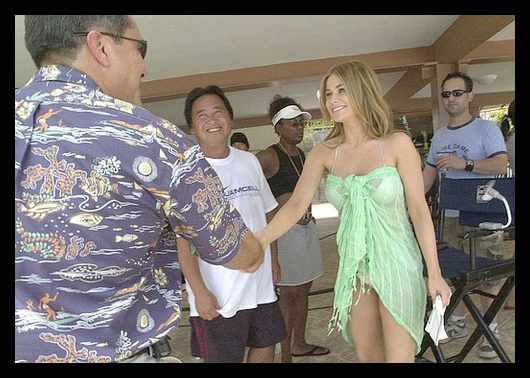 So we flew her to Guam on a deal that was cost effective. But as we ran out of funding , we were forced to make her up to the older sister and cast Guam native Tawny Sablan as the younger sister. This was a good move as Tawny was talented and looked great on camera. This saved flying an LA actress in as well as lodging and per diem. We had expected the traditional incentives a foreign location provides but we underestimated the lack of infrastructure and the production ability locally. Because Laing was funding the film out of pocket, money got very tight. We scrapped plans to cast a Asian star (Shu Qui) and American recording artists White Eyed Pees and Fat Joe. Other Guam costs which were a big surprise were the need to fly in so much and the cost fly it in. We had many corporate sponsors to try to offset costs that most of these were mainland companies were never mentioned by the press. Companies like Kawasaki, White Fly’s, Roxy girl, Optimum Sunglasses, Northwest Airlines and Outrigger Hotels. Equipment suppliers such as Salon Films and Panavision contributed a lot to making our rapidly dwindling budget work. Of the local companies Shooting Star contributed the most. None of this was ever mentioned in any news story and should have been.
So we flew her to Guam on a deal that was cost effective. But as we ran out of funding , we were forced to make her up to the older sister and cast Guam native Tawny Sablan as the younger sister. This was a good move as Tawny was talented and looked great on camera. This saved flying an LA actress in as well as lodging and per diem. We had expected the traditional incentives a foreign location provides but we underestimated the lack of infrastructure and the production ability locally. Because Laing was funding the film out of pocket, money got very tight. We scrapped plans to cast a Asian star (Shu Qui) and American recording artists White Eyed Pees and Fat Joe. Other Guam costs which were a big surprise were the need to fly in so much and the cost fly it in. We had many corporate sponsors to try to offset costs that most of these were mainland companies were never mentioned by the press. Companies like Kawasaki, White Fly’s, Roxy girl, Optimum Sunglasses, Northwest Airlines and Outrigger Hotels. Equipment suppliers such as Salon Films and Panavision contributed a lot to making our rapidly dwindling budget work. Of the local companies Shooting Star contributed the most. None of this was ever mentioned in any news story and should have been.
Finally shooting on Guam was a challenge because things changed so dramatically. As an example we are assurances by the GEDA officials and the GVB that locations would be available to us. So, obviously, we selected Guam's Waikiki Beach to be the central location in the shoot. This enabled a more efficient shoot as the location was right in front of the production hotel. In the script from the start was the use of jet-skis and that's how we secured Kawasaki and several other jet-ski companies to sponsor a world class jet-ski that was to open the film. This would save the film hundreds of thousands of dollars and open the film in a big production fashion. At the last second, the Guam Environmental Dept got involved and objected. That we got all the permissions needed was upsetting to them and when overruled by the Governor - they sought a meeting with me to explain the irreparable damage to coral by the race and could we move miles away to another beach.
Never mind that this cost money in transportation and lost shoot-time not to mention loss of sponsorship because the beach they wanted us to move to was not a famous tourist site not did it have turquoise water, nor a stunning island back drop. We could have shot in this protected location, but wanting to be a good shoot, we deffered to the environmentalist at great expense - which they would not help cover. This made Guam a far more difficult and expensive location than say Hawaii or the Caribbean.
Impact: A lot of people seem to believe that your film was financed fully through money from the government there, but I believe that’s not the case..?
AP: The shoot I was a part of on Guam did not use a cent beyond the money Laing had pledged. John may have paid bills later and for a new version of the film with loan guarantee money, but I am not aware of nor participated in that allocation... in fact I was never paid my director's fee which said a lot about how tight it was for us financially through June 2004! For me personally, it was the worst financial decision I ever made, as I ended up doing the film for free and never recovered my prep or travel costs. The Government loan guarantee was used by Laing after I left. I had no part in it or how it was used. None of the loan guarantee funding was used in the shoot on Guam I was a part of or the post in LA that I was involved in. Our Guam budget was $600,000. Not the $800,000 I had heard about later in the press. The amount we requested from GEDA was to cover the added costs that shooting on Guam and the costs of all the legal work, etc. to apply for their Loan Guarantee. I believe that maximum requested was $400,000. I never saw Laing's financials to know whether he could qualify.
 I did alert GEDA's board in July 2004 that I had left the film and that they should do their due diligence concerning any loan guarantee. I suggested they get in direct contact with the bond company and bank concerning the guarantee and suggest they get a copy of the cut as it existed and speak with a distributor (Lionsgate) about the project's value. This would have given the GEDA board a basis to make a real world decision. We did supply a promotional video of their property to the Outrigger Hotel, commercial to Guam Cell and shot the PSA's for the GVB featuring Carmen Electra. These were done at great expense on 35mm film and with a full professional crew. Was this ever mentioned in the press....sadly, no.
I did alert GEDA's board in July 2004 that I had left the film and that they should do their due diligence concerning any loan guarantee. I suggested they get in direct contact with the bond company and bank concerning the guarantee and suggest they get a copy of the cut as it existed and speak with a distributor (Lionsgate) about the project's value. This would have given the GEDA board a basis to make a real world decision. We did supply a promotional video of their property to the Outrigger Hotel, commercial to Guam Cell and shot the PSA's for the GVB featuring Carmen Electra. These were done at great expense on 35mm film and with a full professional crew. Was this ever mentioned in the press....sadly, no.
Impact: How did you find filming in Guam - and the people there - to work with?
AP: We struggled to crew the picture. After losing the entire Canadian crew because of the H-1 visa issue we had to think about how to do this. We had a few key crew on Guam already, so we moved up the production co-ordinator we had from LA and brought to Guam the producer and tried to put together a crew from LA at the last moment. It was a spotty crew and some were below the crew level and personal quality level I was used to.
Well, it was tough. None of the situations Silva and others purported to be there came to pass. As an example, we had a primarily Canadian crew which had prepped the film in Vancouver prior to plans for them to complete prep on Guam. I asked Chad Stalhinski to be the coordinator and he selected J. J. Perry to coordinate the action on Guam. We learned early on that we had to fly virtually every position in to Guam. This was a nasty surprise for the budget and not what we had been led to believe. We also learned we had to ship every piece of equipment in which was pricey. Guam, we discovered, had very few qualified technicians. Aside from local producer Carlos Baretto and members of his company, there were no experienced crew on Guam. We even worked with the Guam Human Resources Department to train and hire local crew members for the future. Was it ever mentioned in the press that we hired and trained local at-risk people for positions in the production at our cost and then did not apply for incentives that the production was rightfully due? Again, sadly no. it didn't fit into the the story the press wanted to tell so it was not researched or worse, deliberately left out.
From the start the shoot was based on bring in a Canadian crew and the immigration officials and Silva said it'd be no problem to get them work visas, etc. At the last minute, after much money was spent by the Canadian crew on the film prepping in Canada, we found out we could NOT bring in to Guam because of Homeland Security restrictions. This caused me to scramble and attempt to bring in the Indonesian crew who had prepped the film. This also failed to get an okay from Homeland Security.
We also discovered to ship equipment in from LA was cost-prohibitive. So we were really in a bind. Worse, government location use co-operation vanished as well, which meant we would have to rent trucks and location gear to shoot distant locations that had to be "cheated" for actual locations. More budget overage. Worst for me personally, was having to hire a crew out of LA that I didn't know. Several such as Glenda Maddox, Colleen Jones and Paul Cuffee were excellent but (I personally feel) some like Ralph Coons were the worst I had ever worked with.
Coons, who wrote a disparaging article about me and the film, was not someone I would have ever had on my films...but we were stuck and had no replacements. There were some pretty intense conflicts with our local Guam crew and LA crew members like Ralph. But at the last moment we had no choice. And it was unfortunate that he became the press' “go to” source because he told a story they wanted even if it did not represent what really happened.
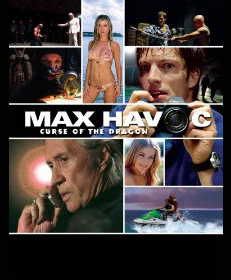 Impact: When did you become aware of what was happening behind the scenes? And when did things start to go wrong and how?
Impact: When did you become aware of what was happening behind the scenes? And when did things start to go wrong and how?
AP: It was months after I left the production and completed the shoot on Guam that the shit hit the fan. Unbeknownst to me, the amount of the loan guarantee had climbed beyond the budget to $800,000. I had a conference call with the GEDA board in August of 2004 and had written GEDA that they had to do there due diligence including getting an assessment from distributors as to the value of the film and the bond company to examine where the funds were going. When I left the film I left a booklet with all the film's local obligations with the bond company. I did see the press the film was getting from time to time, but much of it was not researched and very bias. I feel even Kim Christensen of the Los Angeles Times ignored facts to paint his article the way he (he claimed his editors wanted it to be a certain way) wrote it. It was certainly eye opening how the press slants articles and how little real investigate work they actually do to insure they are telling a factual account of events.
I went into the shoot with the best intentions, and unfortunately things that were outside of my control and my knowledge affected the production. I was publicly blamed everything, even when the facts were there, too many people seemed happy to just throw dirt at me and claim it was me who'd done something wrong or set out to mislead people. Finally now the facts are out there, and i am happy to be able to set the record straight. i hope that people will now look at the film and my involvement differently. I appreciate this opportunity after so many years of inaccuracy. The biggest disappointment was the poor, if not malicious, investigative journalism, even from the Los Angeles Times.
- - -
The first Max Havoc movie eventually hit DVD with additional scenes directed by Isaac Florentine (Undisputed 2 & 3, Ninja series), while a sequel Max Havoc: Ring of Fire directed by Terry Ingram, followed shortly after. In late 2013, it was confirmed by GEDA that John Laing had taken care of the outstanding debts and the matter had been brought to a close.
Albert Pyun’s original Director's Cut of Max Havoc is now available for screening and Pyun hopes to screen it in Guam later this year. For further information on the film and any of Albert’s other projects, visit HERE...
For a first look at the Director's cut visit HERE...








.jpg)
